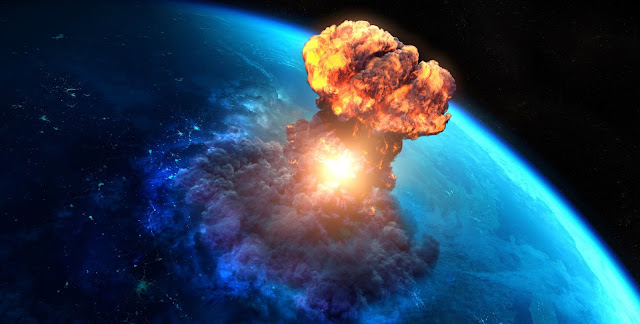 The "Mushroom Cloud" image is one of the most well known and terrifying scenes too. Although nuclear threats have declined over the past decades, there was a time in the twentieth century when fascination and fear of nuclear weapons caused everyone around the world to do somewhat insane matters.
The "Mushroom Cloud" image is one of the most well known and terrifying scenes too. Although nuclear threats have declined over the past decades, there was a time in the twentieth century when fascination and fear of nuclear weapons caused everyone around the world to do somewhat insane matters.The countries of the world that possess nuclear weapons (especially Russia and the United States of America) have tested these weapons underwater, in the mountains, in the air, and even in space!
Maybe we can imagine what these explosions will look like, and what their impact will be, but what about the last explosion? What would happen if a nuclear bomb exploded in space?
During the most dramatic stages of the Cold War, Russia and the United States were testing nuclear bombs in all directions, and all eyes were watching the sky because of the fear of a wide-ranging nuclear weapon, or nuclear warheads guided by satellites.
The United States launched a series of tests, codenamed “Fishbowl Project” which was a high-level nuclear weapons test.
"Starfish Prime" was the most surprising and historic test of this project. On the ninth day of July 1962, a 1.4 megaton nuclear bomb exploded, approximately 250 miles above the ground.
What would happen if a nuclear bomb exploded in space?
First, there was no cloud of a mushroom in its typical form or even a burst wave due to the absence of an atmosphere in space (this causes most of the damage to the planet as a result of a nuclear bomb explosion).Instead, there was a tremendous flow of heat and light, and not only that but rather high-intensity radiation in the form of gamma and X-rays produced without an atmosphere impeding their path. The explosion took a spherical shape, and the wave of radiation and light expanded to illuminate the sky.
On the surface of our planet, it was possible to see bright twilight lights thousands of miles away minutes after the explosion, because the charged particles from the explosion had immediately started interacting with the Earth's magnetic field.
It can be imagined in the form of the “Aurora Borealis”, more commonly known as the Northern Lights, but it has spread kilometers over the Pacific Ocean. The streaks of light and the flow of charged particles would last for hours and even days after the explosion (depending on its size).
Also in the nuclear explosion, there is a small portion of the debris that can ignite in the Earth's outer atmosphere, and heavy ions absorbed by the atmosphere's particles. But in fact, these additional radioactive particles are useful in certain ways (to this day), and we'll explain that in the next paragraph.
Are there other effects of a nuclear bomb exploding in space?
Perhaps the most disturbing thing about the enormous amount of radiation that will collide with the Earth’s atmosphere is the effect of the explosion on the electromagnetic signals within a huge area beneath the explosion.These high-charge, fast-moving electrons will form a small but extremely powerful magnetic field, called an "Electromagnetic Pulse" (EMP).
Arguably you have seen this more than once in science fiction movies; the electromagnetic pulse bomb cuts all electronic communication within a specific space (almost the most famous example of this is the Matrix movie).
In the case of the aforementioned "Sea Star" test, the force of the explosion caused blackouts hundreds of miles away in Hawaii, damage to street lights, malfunctions of radars and navigation systems, and a complete cessation of electronic communications.
Hawaiian residents may have taken it as an unintended consequence, but it showed scientists and researchers the power that a nuclear bomb had exploded in space.
It can damage the infrastructure of a country without even destroying it financially. Now put in your account the size of the bomb used in the "Sea Star" test, which is 1.4 megatons.
Knowing that some of the largest nuclear warheads that were built were hydrogen bombs with a capacity of 50 megaton tons, which means that they are 35 times stronger.
Now imagine the number of lights of the aurora borealis that you could see if a bomb of this force exploded in space, and think about the large-scale technological devastation caused by an electromagnetic pulse large enough to completely disable Texas!
Ultimately, for the long-term effects of a nuclear weapon exploding in space, the radioactive materials that fall into the atmosphere will not go anywhere. But in reality, it will fade across the entire planet.
We can now accurately measure these additional molecules resulting from a nuclear explosion, as a way to know the history of things like trees, wine, and animals.
While this can be a useful thing about nuclear tests in space, it does not make the process as a whole logical or rational.
A few nuclear detonation tests were conducted at high altitudes during the 1950s and also 1960's, but in total, more than 2,000 nuclear detonations were performed on the planet between 1945 and 1998.
The picture is clear. Whether this happens on the ground or in space, the news of nuclear explosions is not good at all!

No comments:
Post a Comment